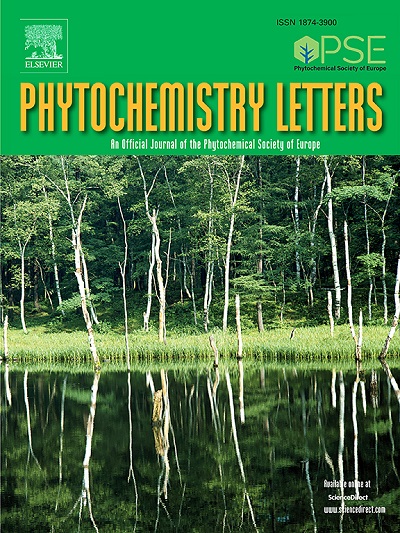薰衣草对神经系统的影响。stoechas
IF 1.3
4区 生物学
Q4 CHEMISTRY, MEDICINAL
引用次数: 0
摘要
薰衣草亚种。传统上,茶茶在民间医学中用于治疗中枢神经系统(CNS)疾病。在本研究中,研究了石竹地上部分乙醇水提取物的潜在神经活性,并进行了植物化学研究,以确定可能负责这种活性的化合物。采用多种色谱方法分离得到5个化合物,通过波谱方法鉴定其结构为木犀草素7-O-β- d -葡萄糖苷、迷迭香酸、戊二醇、1-壬烯和熊果酸。以评估SH-SY5Y细胞脑源性神经营养因子(BDNF)水平为生物筛选工具,发现其提取物、主要组分和分离化合物均可提高BDNF水平。在分离得到的化合物中,浓度为5 μM的熊果酸、浓度为10 μM的戊二醇和熊果酸对BDNF的增加作用最大。此外,还研究了分离的化合物对h2o2诱导的神经细胞损伤的潜在神经保护作用。化合物被发现具有神经保护作用,具有显著活性观察圣草酚的浓度5 μM (p & lt; 0.05)和1-nonadecene 2.5浓度 μM (p & lt; 0.001),5 μM (p & lt; 0.01)和10 μM (p & lt; 0.001)。此外,通过DPPH、SO、NO自由基清除活性、CUPRAC和FRAP等方法证明,石竹草具有较强的抗氧化活性。综上所述,我们的研究结果为传统使用牛蒡子治疗中枢神经系统疾病提供了支持。本文章由计算机程序翻译,如有差异,请以英文原文为准。
The neurologic effects of Lavandula stoechas L. subsp. stoechas
Lavandula stoechas L. subsp. stoechas has traditionally been used in folk medicine for central nervous system (CNS) disorders. In the present study, the potential neuroactive effect of the aqueous ethanol extract of the aerial parts of L. stoechas was investigated, and phytochemical studies were carried out to identify the compounds that may be responsible for this activity. Five compounds were isolated using various chromatographic methods, and their structures were elucidated as luteolin 7-O-β-D-glucopyranoside, rosmarinic acid, eriodictyol, 1-nonadecene, and ursolic acid by spectroscopic methods. Assessing the brain-derived neurotrophic factor (BDNF) level in SH-SY5Y cells was used as a biological screening tool to evaluate the activity, and the extracts, main fractions, and isolated compounds were generally found to increase BDNF levels. Among the isolated compounds, ursolic acid at a concentration of 5 μM, as well as eriodictyol and ursolic acid at a concentration of 10 μM, resulted in the highest increase in BDNF levels. In addition, the potential neuroprotective effects of the isolated compounds against H2O2-induced neuronal cell damage were investigated. The compounds were found to possess neuroprotective effects, with significant activity observed for eriodictyol at a concentration of 5 μM (p < 0.05) and for 1-nonadecene at concentrations of 2.5 μM (p < 0.001), 5 μM (p < 0.01), and 10 μM (p < 0.001). Additionally, L. stoechas demonstrated strong antioxidant activity, as evidenced by DPPH, SO, NO radical scavenging activity, CUPRAC, and FRAP methods. In conclusion, our results provide support for the traditional use of L. stoechas in CNS disorders.
求助全文
通过发布文献求助,成功后即可免费获取论文全文。
去求助
来源期刊

Phytochemistry Letters
生物-生化与分子生物学
CiteScore
3.00
自引率
11.80%
发文量
190
审稿时长
34 days
期刊介绍:
Phytochemistry Letters invites rapid communications on all aspects of natural product research including:
• Structural elucidation of natural products
• Analytical evaluation of herbal medicines
• Clinical efficacy, safety and pharmacovigilance of herbal medicines
• Natural product biosynthesis
• Natural product synthesis and chemical modification
• Natural product metabolism
• Chemical ecology
• Biotechnology
• Bioassay-guided isolation
• Pharmacognosy
• Pharmacology of natural products
• Metabolomics
• Ethnobotany and traditional usage
• Genetics of natural products
Manuscripts that detail the isolation of just one new compound are not substantial enough to be sent out of review and are out of scope. Furthermore, where pharmacology has been performed on one new compound to increase the amount of novel data, the pharmacology must be substantial and/or related to the medicinal use of the producing organism.
 求助内容:
求助内容: 应助结果提醒方式:
应助结果提醒方式:


